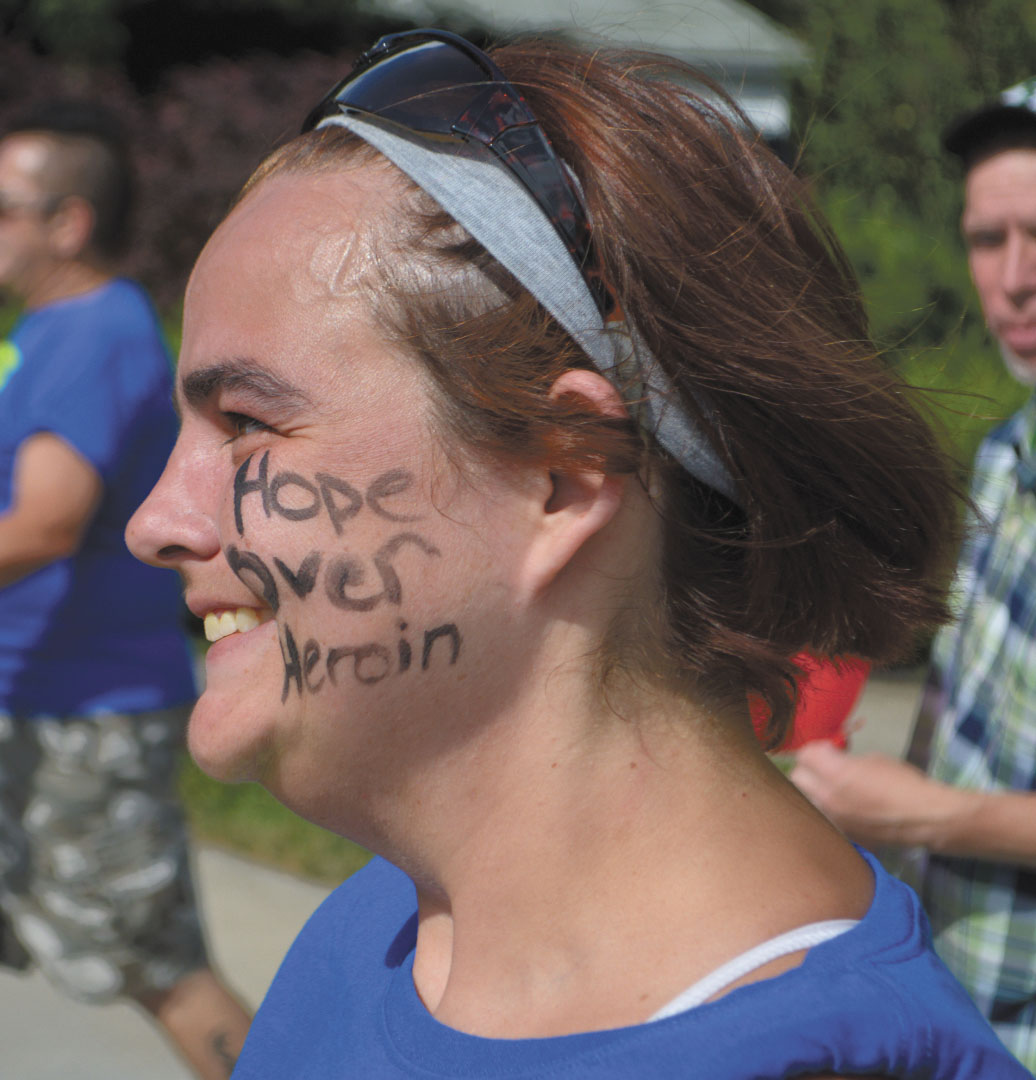As children played in bouncy houses, enjoyed face painting and ate popcorn, the adults nearby shared information on the more serious life challenges of heroin addiction, treatment and a growing number of deaths.
 The Miami County Fairgrounds grandstand area was transformed Friday night July 8 and Saturday July 9 into a venue of pain, sharing and hope for the Hope Over Heroin event coordinated by the young Miami County Heroin Coalition.
The Miami County Fairgrounds grandstand area was transformed Friday night July 8 and Saturday July 9 into a venue of pain, sharing and hope for the Hope Over Heroin event coordinated by the young Miami County Heroin Coalition.
Hundreds of people gathered late afternoon Saturday for a march through Troy streets to the county Courthouse and back to the fairgrounds. The walk was a symbolic call to take back the community, said Aaron Simmons, a Troy firefighter and pastor at the Upper Room Church in Tipp City.
“We are here to take a stand and say, ‘Enough is enough.’” Simmons said.
The march was in memory of those who have been lost and their families and friends. Photos of several who have died – many in their 20s and 30s - were on display at the fairgrounds before being carried by family and friends along the march route.
A sign above a cloth and markers invited thoughts/memories by writing on the cloth about friends and loved ones lost to drugs. “They’re still loved, still missed,” the sign of invitation said.
The responses, many naming those remembered and when they died, talked of how those lost are so deeply missed.
Before the march, representatives of Miami County’s three cities along with some of the around 50 members of the coalition spoke to those gathered. Representatives of several of the nearly 50 churches from across the county involved also spoke of the pain of addictions and death, and their battles to support the afflicted.
Troy Mayor Mike Beamish said the event could be described by the three “c”s: people who care, people who are concerned and a community working toward one goal – to overcome the heroin epidemic.
Beamish said he was proud of the Troy City Council and the city working to form the county’s first Quick Response Team whose members will meet with those who have recently overdosed to see if they are ready for help and treatment. QRT members will include city police and paramedics, a county Recovery Council representatives and, if possible, someone from the faith-based community.
“I would encourage other communities to combine forces like that. We are a pilot,” Beamish said. “Together we can make a difference.”
Tipp City Mayor Pat Hale said the city council approved the hiring of a second police department detective who will work to help fight the heroin issue after hearing of the need for more focus from the police chief.
In Tipp City, two-thirds of today’s ambulance calls are for heroin or other drug-related issues, Hale said. He said he was saddened that the city, like all others, faces those situations but also thankful.
“I was thankful for the Tipp City EMS department, the police department, the fire department, all of our volunteers and those people not only involved in Hope Over Heroin but on a day in and day out basis,” Hale said.
Joe Wilson, the vice mayor of Piqua, said a return of heroin was noticed in the city about eight years ago and its use had grown to an epidemic level after about five years.
“This will be a very difficult problem to overcome. Today is a good first step,” Wilson said, adding more people need to be encouraged to become involved in the response.
Those gathered also heard about resources available in Miami County and surrounding areas for those seeking treatment from Mark McDaniel, executive director of the Tri-County Board of Recovery and Mental Health.
Although he has been in the mental health/recovery field for 37 years, McDaniel said the heroin epidemic is “hard to get your arms around” and has been devastating for so many people.
Steven Justice, a Troy lawyer on the heroin coalition, said issues needing addressed include finding more doctors who can provide medically assisted treatment to addicts during withdrawal, more facilities for safe detox during withdrawal and better education and preventative measures for children and adults.
Justice said the event was considered “a big success” for several reasons including more than 3,000 meals being served on Saturday alone, several hundred people visiting the City of Resources and signing up for treatment/counseling/further information and around 100 people suffering addiction responding to the faith-based message of hope.
“There is hope here,” Simmons said during the program noting 40 churches from across the county were involved in the event along with around 20 agencies offering information on addictions and treatment.
Ministers from several area churches spoke talking about the impact of heroin and other drugs and the role faith can play in addressing them. Two pastors briefly told personal stories of loss to heroin – one of a nephew, the other a former high school football teammate.
“We are asking all pastors and churches partner together with us … We are leading our church to do what God has called us to do to make an impact here in the community,” said Pastor Johnathan Newman of Koinos Church in Troy. “What are seeing in our community and across our nation is a lot of darkness … We’re calling out to our whole community to love our neighbors, and love ourselves.”

